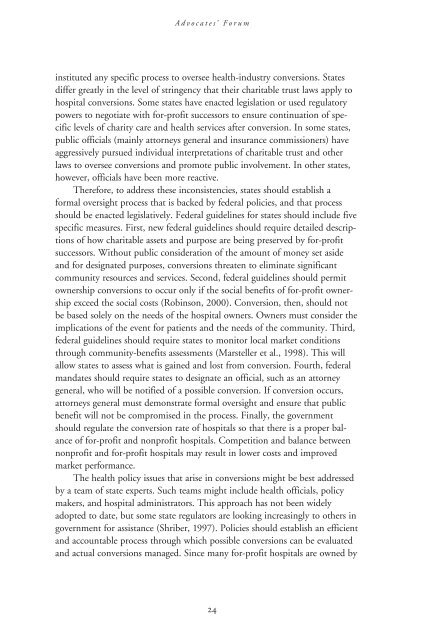2004 - School of Social Service Administration - University of Chicago
2004 - School of Social Service Administration - University of Chicago
2004 - School of Social Service Administration - University of Chicago
You also want an ePaper? Increase the reach of your titles
YUMPU automatically turns print PDFs into web optimized ePapers that Google loves.
Advocates’ Forum<br />
instituted any specific process to oversee health-industry conversions. States<br />
differ greatly in the level <strong>of</strong> stringency that their charitable trust laws apply to<br />
hospital conversions. Some states have enacted legislation or used regulatory<br />
powers to negotiate with for-pr<strong>of</strong>it successors to ensure continuation <strong>of</strong> specific<br />
levels <strong>of</strong> charity care and health services after conversion. In some states,<br />
public <strong>of</strong>ficials (mainly attorneys general and insurance commissioners) have<br />
aggressively pursued individual interpretations <strong>of</strong> charitable trust and other<br />
laws to oversee conversions and promote public involvement. In other states,<br />
however, <strong>of</strong>ficials have been more reactive.<br />
Therefore, to address these inconsistencies, states should establish a<br />
formal oversight process that is backed by federal policies, and that process<br />
should be enacted legislatively. Federal guidelines for states should include five<br />
specific measures. First, new federal guidelines should require detailed descriptions<br />
<strong>of</strong> how charitable assets and purpose are being preserved by for-pr<strong>of</strong>it<br />
successors. Without public consideration <strong>of</strong> the amount <strong>of</strong> money set aside<br />
and for designated purposes, conversions threaten to eliminate significant<br />
community resources and services. Second, federal guidelines should permit<br />
ownership conversions to occur only if the social benefits <strong>of</strong> for-pr<strong>of</strong>it ownership<br />
exceed the social costs (Robinson, 2000). Conversion, then, should not<br />
be based solely on the needs <strong>of</strong> the hospital owners. Owners must consider the<br />
implications <strong>of</strong> the event for patients and the needs <strong>of</strong> the community. Third,<br />
federal guidelines should require states to monitor local market conditions<br />
through community-benefits assessments (Marsteller et al., 1998). This will<br />
allow states to assess what is gained and lost from conversion. Fourth, federal<br />
mandates should require states to designate an <strong>of</strong>ficial, such as an attorney<br />
general, who will be notified <strong>of</strong> a possible conversion. If conversion occurs,<br />
attorneys general must demonstrate formal oversight and ensure that public<br />
benefit will not be compromised in the process. Finally, the government<br />
should regulate the conversion rate <strong>of</strong> hospitals so that there is a proper balance<br />
<strong>of</strong> for-pr<strong>of</strong>it and nonpr<strong>of</strong>it hospitals. Competition and balance between<br />
nonpr<strong>of</strong>it and for-pr<strong>of</strong>it hospitals may result in lower costs and improved<br />
market performance.<br />
The health policy issues that arise in conversions might be best addressed<br />
by a team <strong>of</strong> state experts. Such teams might include health <strong>of</strong>ficials, policy<br />
makers, and hospital administrators. This approach has not been widely<br />
adopted to date, but some state regulators are looking increasingly to others in<br />
government for assistance (Shriber, 1997). Policies should establish an efficient<br />
and accountable process through which possible conversions can be evaluated<br />
and actual conversions managed. Since many for-pr<strong>of</strong>it hospitals are owned by<br />
24
















